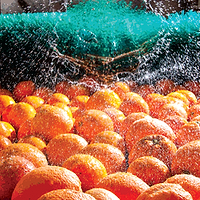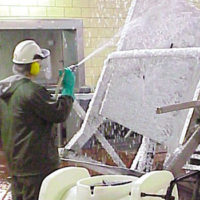In the food industry, chemicals are routinely used to sanitize and disinfect product contact surfaces. These chemicals provide a necessary and required step to ensure that the foods produced and consumed are as free as possible from microorganisms that can cause foodborne illness. Prevention is the name of the game. What are these chemicals, how do they function and how are they used?
Disinfecting Versus Sanitizing
Before discussing the chemicals, the differences between sanitizers and disinfectants as used in the food industry must be understood. To disinfect means to destroy or irreversibly inactivate specified infectious fungi and bacteria, but not necessarily the spores, on hard surfaces.[1] To sanitize means to reduce microorganisms of public health importance to levels considered safe, based on established parameters, without adversely affecting either the quality of the product or its safety.[2] While disinfection measures may be employed in food processing and preparation, it is much more common to utilize sanitization methods to reduce microbial presence.
To achieve the required level of sanitization or disinfection, the chemical in question must be applied at a certain concentration for a specified amount of time. These parameters are described on the product label and must be followed to achieve the desired microbial control. In most cases, these products are registered for use as pesticides with the U.S. Environmental Protection Agency (EPA). Once applied, the allowable residues and the monitoring thereof in food processing and preparation are the responsibility of the U.S. Food and Drug Administration. Facilities operating under the jurisdiction of the U.S. Department of Agriculture must additionally use products approved by that agency. Of course, the task of ensuring the chemicals are prepared and applied properly to avoid inappropriate residues rests with the food processor and foodservice operator.
The efficacy of a chemical used for sanitizing or disinfection rests upon its ability to reduce the contamination level. The sanitization standard for contamination reduction of food contact surfaces is generally accepted as 99.999% (a 5-log reduction) achieved in 30 seconds (Official Detergent Sanitizer Test).[3] The sanitization standard for nonfood contact surfaces is accepted as a reduction of 99.9% (3 logs) within 30 seconds. Disinfection, in contrast, must destroy or irreversibly inactivate all specified organisms within a certain time, usually 10 minutes. Some chemicals may function as both sanitizers and disinfectants.
The process of sanitization depends upon the preparation of the surfaces in question. Most sanitizers must be applied to surfaces that are free of organic matter and cleaner residues. The generally accepted order of events is rinse, clean, rinse and sanitize. The cleaner utilized in the cleaning step needs to be oriented and appropriate for the soil present. For example, alkaline detergents more efficiently remove fat- and protein-based soils, while mineral-based soils require acid cleaners. Thankfully, modern cleaning agents are mixtures of chemical components that can address various cleaning scenarios.
Sanitizing Chemicals
The food industry most often uses sanitizing procedures, so the information presented herein will focus on the more common products utilized. Regardless of the product, the sanitizing solution must be tested to verify that the desired concentration is consistently present. Too little sanitizer, of course, can result in unacceptable efficacy, while too much sanitizer can yield residues that do not meet standards.
Hypochlorites
Effectiveness, low cost and ease of manufacturing make hypochlorites the most widely used sanitizers. Sodium hypochlorite is the most common compound and is an ideal sanitizer, as it is a strong oxidizer.
Hypochlorites cause broad microbial mortality by damaging the outer membrane, likely producing a loss of permeability control and eventual lysis of the cell.[4,5] In addition, these compounds inhibit cellular enzymes and destroy DNA. Spores, however, are resistant to hypochlorites, as the spore coat is not susceptible to oxidation except at high concentrations coupled with long contact times at elevated temperatures.
While hypochlorites are very reactive, their useful properties are negatively impacted by factors such as suspended solids, high temperatures, light, water impurities and improper pH levels. In routine use, surfaces must be as free as possible of organic materials, and the pH must be maintained between 5 to 7 to ensure that the greatest amount of hypochlorous acid is available. As with any sanitizer, measurements must be taken periodically to make certain that the freely available chlorine is at the desired level. For no-rinse applications, the maximum allowable concentration of available chlorine is 200 ppm.
Other disadvantages of hypochlorites are corrosiveness to metals, health concerns related to skin irritation and mucous membrane damage and environmental contamination. The latter is of concern as chlorine can combine with organic substances to form toxic chlorinated compounds, such as trihalomethanes and dioxins. Hypochlorite use may be further restricted in the future. Care must be taken when cleaning hypochlorite spills as organic materials such as cloth, sawdust and paper may spontaneously combust upon drying.
Chlorine Dioxide
This inorganic compound is a broad sanitizer effective against bacteria, fungi and viruses. Chlorine dioxide is an oxidizer that reacts with the proteins and fatty acids within the cell membrane, resulting in loss of permeability control and disruption of protein synthesis.[6,7]
While chlorine dioxide is an explosive gas, it is relatively safe in solution. It is produced on-site as it can’t be compressed or stored commercially in gaseous form. Most chlorine dioxide generation is accomplished with complex systems. However, recent advances in formulation procedures allow the production of solutions of chlorine dioxide on-site without the use of expensive equipment.
Compared with hypochlorites, chlorine dioxide requires much lower concentrations to achieve microbial mortality. For example, a 5-ppm solution is effective as a sanitizer on food contact surfaces with a contact time of at least 1 minute. Further, disinfection can be achieved with 100 ppm using a contact time of 10 minutes.
Chlorine dioxide reacts more selectively with compounds present in microbial cells as opposed to reacting with organic compounds in general. This ability allows chlorine dioxide to function in more organically loaded solutions, though as organic load increases, efficacy does decrease. Chlorine dioxide functions well over a pH range of about 6 to 10, thus allowing increased mortality of some microbes at higher values. Another advantage is that chlorine dioxide does not form chlorinated organic compounds, making it more environmentally friendly.
Iodophors
These compounds are less active than hypochlorites but are effective sanitizers and disinfectants. Iodophors attach to the sulfurs of proteins such as cysteine, causing inactivation and cell wall damage.[8] Carriers with iodophor solutions allow a sustained-release effect, resulting in continuous microbial mortality.
Iodophors fare better in situations in which the pH is slightly acidic, as less active forms exist above neutral pH. The common concentration for sanitization is 25 ppm for 1 minute. Unfortunately, iodine compounds easily stain many surfaces, particularly plastics. On the plus side, they are common sanitizers used on glass surfaces, such as in the beer and wine bottling industries. The EPA has assessed iodophors as having no significant effect on the environment.[9]
Peroxyacetic Acid (PAA)
PAA is an effective sanitizer that is active against many microorganisms and their spores. Mortality is produced by the disruption of chemical bonds within the cell membrane.[10] PAA-based sanitizers are frequently paired with stabilized hydrogen peroxide. These sanitizers function well under cold conditions (~ 4 °C), thus producing acceptable microbial mortality on equipment normally held below ambient temperature. PAA is also effective in removing biofilms and is more active than hypochlorites.[11]
PAA solutions can be attenuated by the organic load and will begin to lose activity as the pH approaches neutral. These solutions are applied at concentrations ranging from about 100 ppm to 200 ppm for peroxyacetic acid and 80 ppm to 600 ppm for hydrogen peroxide.
PAA-based sanitizers are environmentally friendly as the compounds therein break down into acetic acid, oxygen and water. These sanitizers are also less corrosive to equipment than hypochlorites. As with any highly active oxidizer, concentrated PAA can present a safety hazard.
Quaternary Ammonium Compounds (QACs or Quats)
Quaternary ammonium compounds are fairly complex chemicals in which nitrogen is bound to four organic groups. The positively charged cations in the compounds bind with the acidic phospholipids in the microbial cell wall.[12] This action blocks the uptake of nutrients into the microbial cell and prevents the discharge of waste. In general, QACs are effective against a wide range of microbes, although the spore phase is unaffected. At lower concentrations, Gram-positive bacteria are more sensitive to QACs than Gram-negative bacteria.10 QACs are formulated in many different variations for specific situations.
QACs may be applied at concentrations varying from about 100 ppm to 400 ppm. As sanitizers, QACs are commonly applied at 200 ppm to food contact surfaces, and the solution is allowed to dry. Once dry, a residue of the QAC compounds remains and provides germicidal activity until degradation occurs. QACs also can function as detergents when present in high concentration because the compounds possess both hydrophilic and lipophilic chemical groups.
QACs are usually odorless, nonstaining, noncorrosive and relatively nontoxic to users. They function well over a broad temperature range and a wide pH range, although activity is greater at warmer temperatures and in alkaline situations. While QACs tolerate light organic loads, heavy soil will decrease QAC activity significantly. Some QACs may not function adequately in hard water, but others are formulated with added chelating agents that allow such use.[11]
While QACs do combine with organic compounds and are discharged into the environment, the concentrations are low and heterotrophic bacteria are not negatively impacted.[13] Soil-inhabiting bacteria such as Pseudomonas spp. and Xanthomonas spp. can degrade QACs.[14] In addition, the low amounts of QACs flowing into commercial sewage treatment facilities appear to combine with the anionic surfactants present to form complexes that reduce or eliminate toxicity.[15]
Resistance to Sanitizers
Any time a chemical is used to produce microbial mortality, the possibility of promoting resistance exists. This is because not all of the microbes are killed. A 5-log reduction (99.999%) still means that of 1,000,000 microbes present, 10 have survived, even though the process has reduced the population to what can be termed a safe level. The sanitizer could have just missed these 10 organisms or they could inherently be immune. If these 10 microbes are indeed immune, over time they will proliferate, and the usual sanitizing concentration and/or chemical will no longer produce acceptable mortality. At this point, measures must be taken to disinfect the surfaces in question. It then becomes imperative to know what organisms are specifically present so that the proper disinfectant at the proper strength maintained for the required time can be applied.
Sometimes, it is thought that bacterial resistance is present when actually the organisms are avoiding contact with the sanitizing chemical because a biofilm is present. Biofilms are polysaccharides that allow attachment to most any surface. Bacteria such as Escherichia coli, Salmonella spp., Listeria spp., Campylobacter spp. and several others can produce biofilms. Over time, the film becomes enhanced and may contain different species of bacteria, yielding a constant source of contamination. Whether biofilms are truly products of bacterial resistance may be a philosophical question, but the presence of biofilms can be an indisputable problem for those assigned to find a solution.
Conclusions
As you probably have noted, no mention has been made of another chemical used extensively, namely, water. Various forms of water can sanitize, but, as stated initially, the focus of this discussion was on the more common chemicals traditionally used for sanitization.
Allan Pfuntner, M.A., REHS, is with Hartono and Company LLC. He can be reached at apfuntner@msn.com.
References
1. U. S. Environmental Protection Agency, Antimicrobial Pesticide Products Fact Sheet.
2. Code of Federal Regulations, Title 21, Sec. 110.3.
3. AOAC International Official Methods of Analysis. 2009. AOAC International, Gaithersburg, MD.
4. Venkobachar, C., L. Iyengar and A.V.S.P. Rao. 1977. Mechanism of disinfection: Effect of chlorine on cell membrane functions. Water Res 11:727–729.
5. Virto, R., P. Mañas, I. Alvarez, S. Condon and J. Raso. 2005. Membrane damage and microbial inactivation by chlorine in the absence and presence of a chlorine-demanding substrate. Appl Environ Microbiol 71:5022–5028.
6. Berg, J.D., P.V. Roberts and A. Matin. 1986. Effect of chlorine dioxide on selected membrane functions of Escherichia coli. J Appl Bacteriol 60(3):213–220.
7. EPA, Guideline Manual, Alternative disinfectants and oxidants. April 1999.
8. McDonnell, G.E. 2007. Antisepsis, disinfection and sterilization. Washington, DC: ASM Press.
9. EPA Ecological Hazard and Environmental Risk Assessment and Environmental Fate. Docket number EPA-HQ-OPP-2006-0599.
10. Block, S.S. 2001. Disinfection, sterilization and preservation. Philadelphia: Lippincott, Williams and Wilkins.
11. Schmidt, R.H. 2003. Basic elements of equipment cleaning and sanitizing in food processing and handling operations. University of Florida Extension Document FS14.
12. McBain, A.J., R.G. Ledder, L.E. Moore, C.E. Catrenich and P. Gilbert. 2004. Effects of quaternary-ammonium–based formulations on bacterial community dynamics and antimicrobial susceptibility. Appl Environ Microbiol 70(6):3449–3456.
13. Ventullo, R.M. and R.J. Larson. 1986. Adaptation of aquatic microbial communities to quaternary ammonium compounds. Appl Environ Microbiol 51(2):356–361.
14. Raymond, D.D. and M. Alexander. 1977. Bacterial metabolism of quaternary ammonium compounds. Appl Environ Microbiol 33(5):1037–1041.
15. Boethling, R.S. 1984. Environmental fate and toxicity in wastewater treatment of quaternary ammonium surfactants. Water Res 18(9):1061–1076.
>




